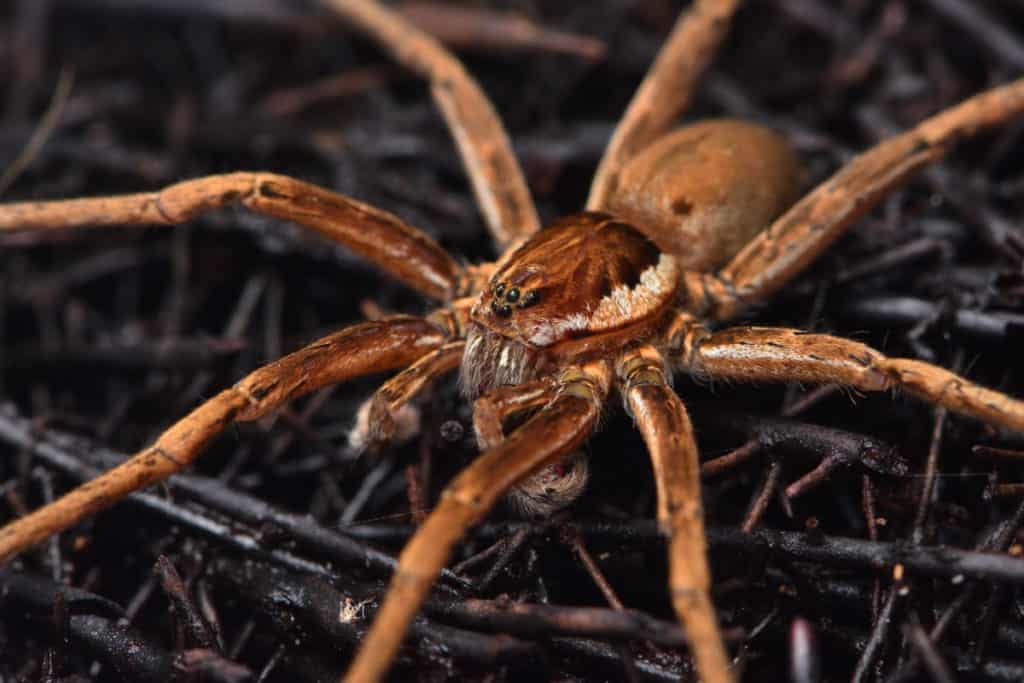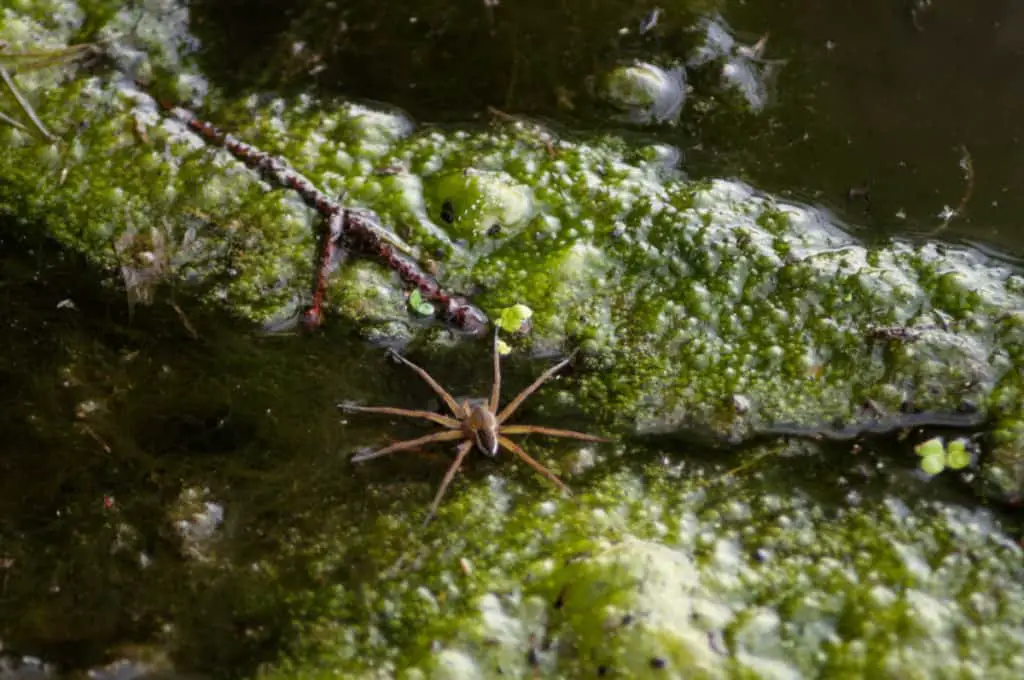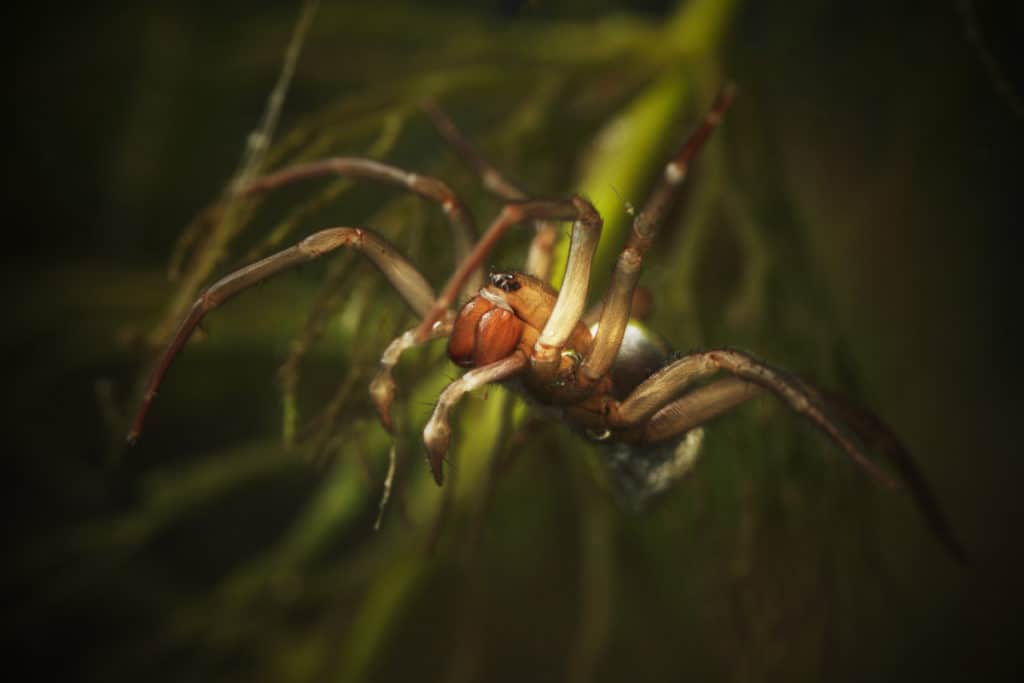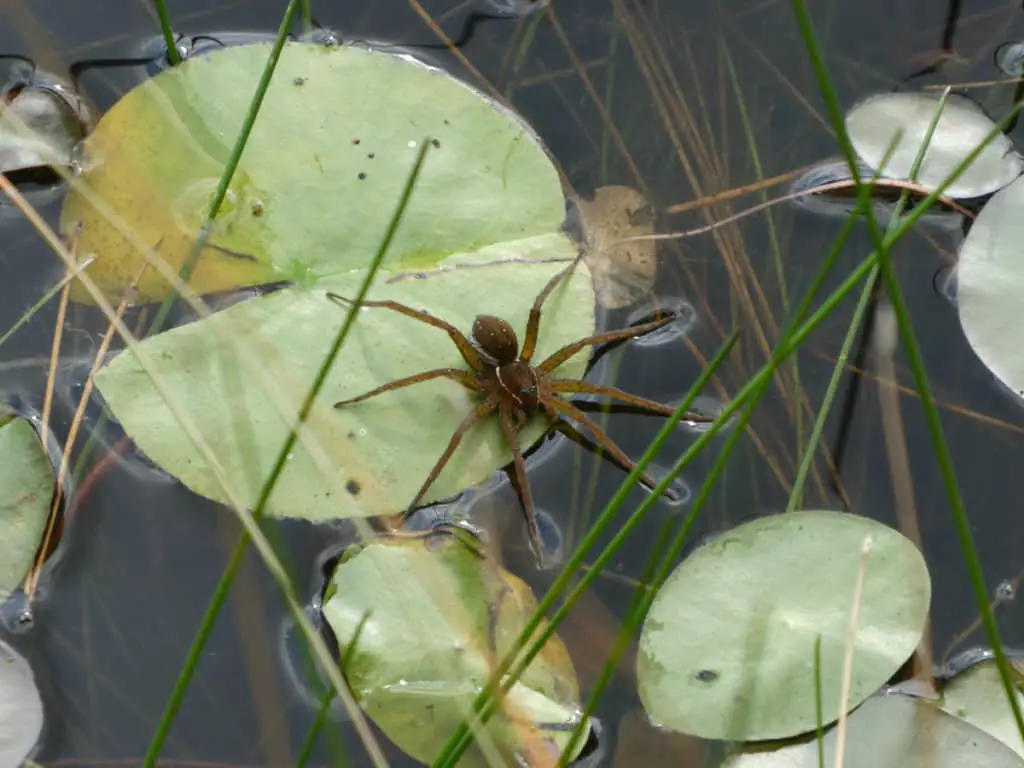Some spider species have adapted to living in habitats near or in water bodies such as streams, wetlands, swamps and marshes, fens, lakes, and seashores.
Can the eight-legged arthropod swim?
Yes, some spiders can swim well, some float comfortably and can thrust downward if they want to dive underwater, while others propel themselves on water clumsily. There’re species of aquatic spiders, semi-aquatic spiders, and marine spiders, all with different abilities and habits when swimming.
Some examples of spiders that can swim are:
- Giant water spider
- Raft spiders
- Diving bell spider
- Tarantulas
- Dolomedes Briangreenei (new species)
There are terrestrial spiders species that are strictly land dwellers and don’t take to water willingly. Examples of spiders that are not swimmers:
- Brown recluse
- House spiders
- Black widow spiders
- Huntsman spiders
- Daddy longlegs spiders
Let’s dive into the details of what spider species can swim and how they perform hunting, running feats on the surface of the water, or submerging underwater.
Are There Spiders That Actually Swim?
Among spiders that can swim are Dolomedes species (Pisauridae family), sometimes referred to as fishing spiders which include;
- Raft spiders
- Dock spiders
- Wharf spiders
- Giant fishing spiders
- Dolomedes triton sexpunctatus

Almost all spiders in Dolomedes species are semi-aquatic; they live partly on land and water.
The research on these spiders reveals some interesting insights into their way of life in water.
Dolomedes Aquaticus (Pisauridae family)
This is a semi-aquatic fishing spider common in deforested open rivers and lakeshores of New Zealand. It lives under rocks in proximity to the water, usually less than 5 meters from the river, and hunts along the gravel banks of the rivers. It is a nocturnal spider that normally sits and waits for its prey after dark.
It can dive and remain underwater for short periods. Dolomedes Aquaticus can run at a fast pace on the water surface and when startled, it runs to the nearest object upon which it runs down and escapes to the bottom of the water. It remains there till all danger passes.
Dolomedes Fimbriatus Or Raft spiders (Pisauridae family)
Commonly known as the raft spider, it is found throughout north-western and central Europe, these are large spiders that prefer freshwater wetlands and acid swamps.

Typically, the raft spiders hunt on the surface of the water. It can fully submerge itself in water for several minutes to avoid predators like birds.
Dolomedes Briangreenei
Also known as the Brisbane spider, this new Australian species is a large spider that is about the size of the palm of an adult’s hand with its legs stretched out. This spider is an excellent swimmer and preys on fish, frogs, tadpoles, and the invasive cane toad. When hunting, it uses vibrations on the surface of the water made by potential prey to navigate and find it.
The spider can feel vibrations in the water made by its prey using its sensitive legs. If threatened, they will plunge through the surface of the water and swim quickly to hide on the bottom. They are quite adept at running fast on the surface of the water with their two middle pairs of legs.
Dolomedes Bondalei (Pisauridae family)
This is a small fishing spider that occurs in the main islands of New Zealand. It has a body length of 18-25mm in females. It is closely related to Dolomedes Aquaticus, but it prefers shaded rivers or lakes with indigenous forests or dense vegetation. This spider weighs less than a gram and is covered with hydrophobic hairs that enable it to run or walk on the water surfaces without sinking.
Giant Water Spider Or Megadolomedes Australianus (Pisauridae family)
This giant spider is one of Australia’s largest spiders and is commonly referred to as the giant water spider. It has a leg span of up to 18 centimeters. It is found along the water edge in creeks, rivers, and lakes. This spider is able to run swiftly across the surface of the water. Because of their ability to trap air around their body and leg hairs, they can stay submerged for a long time. They prey on small fish, tadpoles, and insects found in their water habitats.
Are There Spiders That Go Underwater?
Diving Bell Spider (Argyroneta Aquaticus)
Diving spiders, also known as the water spider is native to Europe and Asia. It occurs in clean freshwater environments such as lakes, ponds, canals, marshes, and slow-moving streams with abundant aquatic vegetation.

The diving bell spider utilizes an underwater flexible silk web to trap air that enables it to spend its entire life underwater. It is the only species of spider known to have the unique ability to literally live in an inflated underwater house. Thus, it can be described as an aquatic creature. They are able to hunt, mate, lay eggs and rest without dry land.
It overwinters underwater. Occasionally, it becomes necessary to replenish the air within the web. The water spider swims to the water’s surface where it captures tiny bubbles of air in the fine hairs on its body. It then transports them back to its silk web, which is attached to underwater plants or other objects. It ejects the air bubbles inside, thereby inflating the diving bell.
The spider swims to the surface of the water about once each day to replenish the air supply in the inflated web because the web tends to collapse. According to research, the inflated web serves as a sort of gill. It extracts dissolved oxygen from the water when the oxygen level inside the web becomes sufficiently low to draw oxygen in from the water.
Marine Spiders: Desis Spider (Desidae family)
These are true marine spiders living on the foreshore or seashore. This is the area above water level at low tide and underwater at high tide. This environment can be harsh with extremes to sunlight exposure and near-freezing temperatures in colder climates.
Desis spiders emerge at night on the ebb of the tide to hunt. In the day and during high tides, they take refuge in an underwater air chamber sealed with silk. Due to fine air-trapping hairs on the tips of their legs they can walk on water. The fine hairs on their feet wrap air and act like small buoys that enable the spiders to stay afloat.
Do Spiders Hunt Prey Underwater?
The diving bell spiders do hunt prey underwater. They can capture underwater prey and consume it underwater, but they can occasionally surface with prey.
The following are some other species that hunt underwater:
- Giant water spider
- Dolomedes briangreenei
- Dolomedes aquaticus
- Marine spider(Desis)
How Long Can Spiders Stay Underwater?
Except for the Diving bell spiders which actually live underwater, the rest of the semi-aquatic spiders can stay submerged for short periods of time. Dolomedes species, as we have mentioned previously, are well adapted to diving periodically. When evading predators like birds they can dive and stay underwater until the danger passes. They also dive when hunting for prey, particularly those that tackle fish.
Ancylometes Species (Ctenidae family)
The Ancylometes species also known as wandering spiders, can walk on water and are accomplished divers. They can stay underwater for prolonged periods, over an hour at a time. Their book lungs are surrounded by hairs that trap air and enable them to stay submerged for long. The duration of time spent underwater at a stretch depends on how much air the spider can trap in the hairs on its body and legs.
Arctosa Fulvolineata (Lycosidae family)
These spiders belong to the wolf spider species and live in saltmarshes under lumps of mud and can be found in wet tightly matted debris along the foot of the sea wall. These habitats flood periodically and the wolf spiders (Arctosa) enter into a coma-like state for up to 16 to 36 hours.
During this time wolf spiders can lower their metabolic rate. The low metabolic rate allows the wolf spider to stay comfortably submerged in water or in mud.
Are There Spiders That Can Walk On Water?
Most Dolomedes semi-aquatic species can not only dive and swim, but they can also walk and run at a fast pace on the surface of the water. Spiders are able to walk on water with the help of their specially adapted legs and feet that have hydrophobic hairs that repel water. Meaning they don’t get wet.
Instead, tiny bubbles are trapped in the hairs and act like tiny buoys. Some spiders that can walk on water as we have seen earlier in this post are:
- Megadolomedes Australianus
- Ancylometes
- Dolomedes Aquaticus
- Dolomedes Dondalei
- Dolomedes Fimbriatus (Raft Spider)
- Nursery Web Spider
How Can Spiders Walk On The Surface Of Water?
The water’s surface tension pushes the water spiders forward. By sweeping their middle pair of legs backward in a sculling motion, spiders create swirls beneath the water’s surface that propel them forward.
How Do Spiders Hunt Prey On The Water?
Water or fishing spiders are semi-aquatic and hunt more on the water than dry land. These species of spiders don’t build webs to trap prey. Instead, when hunting for insects they hold on to the shore with their back legs while the rest of their body lies on the water with the legs outstretched.

Because of their robust build with thickset legs, they can subdue prey larger than themselves. They use their sensitive front legs to feel the vibrations carried on the water, just as other spiders feel the vibrations in a web. They are able to discern and filter out the background noise of wind or the flow of water around rocks or plants.
They have a range of vibration-detecting organs. These include very sensitive hairs on their legs and feet which allow them to identify the source of vibrations, the distance to, and the direction of the source.
If they detect prey, they move with speed across the water to capture and immobilize the victim. But they are also opportunistic predators and will eat anything that crosses their path.
If you would like to know more about the sensory abilities of spiders we have an article that you might find interesting, Do Spiders Have A Nose?
Can Spiders That Can’t Swim Survive If They End Up In Water?
Spiders that can’t swim don’t drown easily and they will row clumsily with their legs to try to get out of the water. If they come across floating debris like leaves they can only hold on for dear life. If they end up in a swimming pool they struggle endlessly to get out.
But essentially, they cannot survive for very long in the unfamiliar watery environments for which nature has not equipped them. They can’t swim, let alone dive to escape predators or hunt in water.
Do Spiders Sail On Water?
Many spiders in the Pisauridae family inhabit the edges of freshwater rivers, lakes, streams, and swamps. They actively propel themselves across the water using both rowing and galloping movements of their legs. Quite interestingly, they can also sail across the water.
They take advantage of the wind and their nearly frictionless motion when they interact with the water surface. The slipperiness of the water’s surface aids the spiders as they stand with two or three pairs of legs up in the air and allow the wind to catch them and propel them across the water’s surface.
They can travel in this way for considerably long distances while expending almost no energy.
The Wrap Up
Fishing spiders in the Dolomedes genus are well adapted to swimming and living around freshwater bodies. They are capable swimmers, divers, and water striders and can hunt prey almost three times their size.
These spiders are semi-aquatic and live partly on land and in water. The Diving bell spider is the only known species that spends its entire life underwater.
Those species that can’t swim cannot survive in water because they don’t have the ability to hunt, dive or do the things that only fishing spiders can. They are most comfortable in dryland habitats.
If you are interested we have some other articles that talk about the ability of bugs to swim:
Do Bees Have Lungs? (With Video Of Bee Breathing)
Sources
https://www.sciencelearn.org.nz/resources/673-new-zealand-s-fish-eating-spider
https://www.nationalgeographic.com/news/2016/03/160311-brian-spider-dolomedes-briangreenei/
https://www.sciencealert.com/scientists-found-a-new-spider-in-australia-that-can-swim-and-catch-fish
https://en.m.wikipedia.org/wiki/Dolomedes_dondalei
https://en.m.wikipedia.org/wiki/Dolomedes
https://en.m.wikipedia.org/wiki/Diving_bell_spider
https://www.britannica.com/animal/water-spider
https://www.scientificamerican.com/article/how-is-it-possible-for-in/
